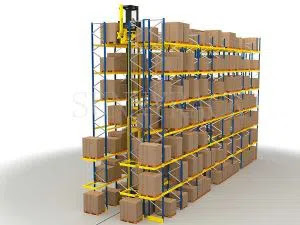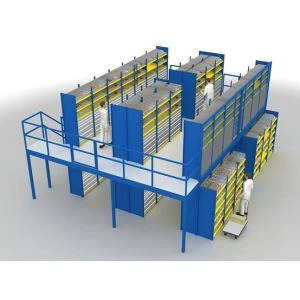Different Types Of Pallet Racking Systems
Pallet racking system, as we all know, is an effective way of increasing storage space in factories and warehouses. These help to improve functionality and increase productivity, as by using pallet racks, industrialists can keep their products better organized. Individual pallets, also known as "skids", are made from different types metals, plastic and wood and are amalgamated into the larger rack structures that have shelves on different and multiple levels. The decking base, manufactured in varying widths, is used to support the objects that are stored on top of the shelves. These decks are generally manufactured out of a wire mesh that supports the items, and also helps to maintain an inventory of the items that have been placed on top of it. Forklifts are generally used to load the products on to the shelves as these racks may be several feet high. The basic structure of pallet racks are either of the following: a) roll form, that is, columns are supported by the beams; b) structural form, where the beams are mostly bolted. Standard configurations of pallet racks include drive-through/drive-in racks, push-back racks, flow racks and selective racks. Let us look into these categories in details.
Different Types Of Pallet Racks:
Drive-through, or drive-in racks: These are structures that are designed to support high-density storage. Drive-through, or drive-in racks are manufactured out of steel, and have enough space between the bays, or stack lanes to allow the movement of forklifts.
Push-back racking systems: These are manufactured in structural, or roll forms. Push-back racking systems are the perfect option for storing materials in bulk volume. They are also designed to accommodate items that occupy several pallets in width, as well as height. When an individual pallet is loaded onto the structure, it tends to push back the adjoining pallet from its original position on the rail. During the process of unloading products, the pallets that lie at the back are pushed move forward. Just like drive-in storage structures, push-back systems follow the LIFO system of storage and are capable of storing materials in large volumes.
Flow Racks: Flow racks are synonymously referred to as gravity-flow racks and are the best option for storing items of high density. Items are generally deposited at higher-points, and unloaded from the lower-end. In short, it employs the FIFO loading-system. Racks automatically start rotating with the gradual loading of the products onto the shelves.
Selective Racks: Manufacturing experts state that this is the most common type of pallet racking system that is used in warehouses. Pallets can be accessed from the aisle. Beams are generally used to support the pallet systems. Selective racking systems can be customized according to the need, and they can be implemented in narrow, standard, or deep reach aisles.
Choosing the correct racking system is an important part of improving the functionality of your warehouse. Therefore, it is best to be aware of different storage systems that are available to make the best choice.
Nanjing Sunnyrack Manufacturing Co.,Ltd, established in September 2006, is one of the earliest and biggest manufacturers which dedicated to researchingdesigningmanufacturing and installing various storage rack systems in China. Browse our website for more details.



Comments
Post a Comment